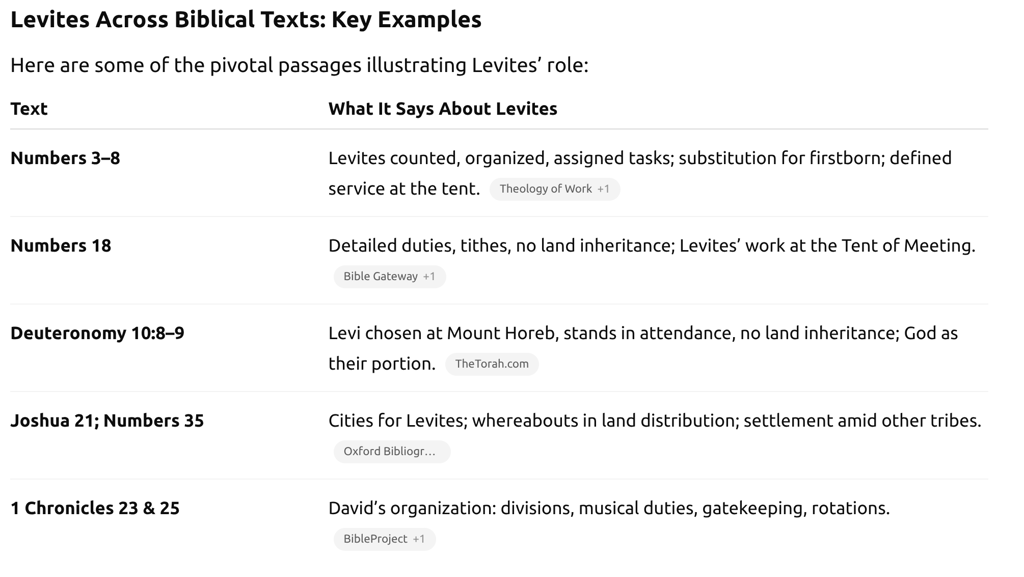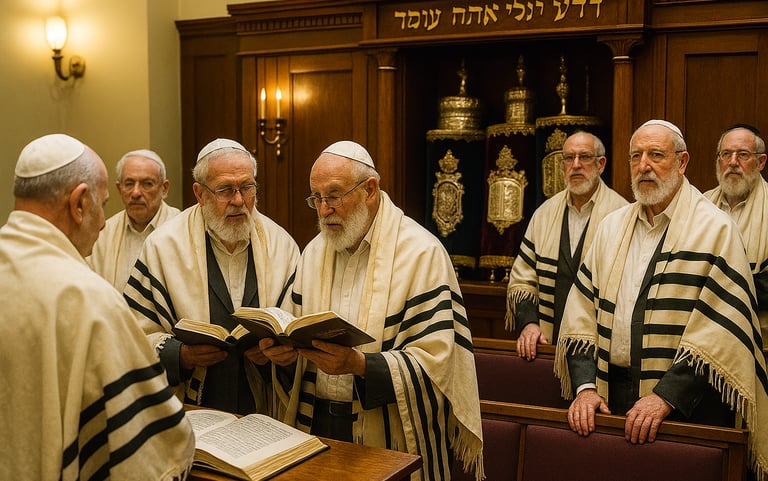𝗪𝗛𝗢 𝗔𝗥𝗘 𝗧𝗛𝗘 𝗟𝗘𝗩𝗜𝗧𝗜𝗘𝗦 𝗜𝗡 𝗧𝗛𝗘 𝗕𝗜𝗕𝗟𝗘
𝗪𝗛𝗢 𝗔𝗥𝗘 𝗧𝗛𝗘 𝗟𝗘𝗩𝗜𝗧𝗜𝗘𝗦 𝗜𝗡 𝗧𝗛𝗘 𝗕𝗜𝗕𝗟𝗘
GOSPEL AND SPIRITUALITY
MrTruth.Tv
9/19/20256 min read
In the annals of Biblical history, among the twelve tribes of Israel, the Levites occupy a special place. Unlike their siblings, they are not known primarily for territorial inheritance or military conquests. Rather, the Levites are set apart for religious, liturgical, and service functions — mediating between the divine and the people, maintaining worship, and teaching the law. But who exactly are they, what were their origins, what functions did they serve, and how did their role evolve over time? This article examines the Levites in the Hebrew Bible, drawing upon textual and scholarly sources to sketch a full portrait.
Origins of the Levites
Genealogical Roots
The Levites are descendants of Levi, the third son of Jacob and Leah. Levi is one of the twelve patriarchs whose children become the tribes of Israel. Oxford Bibliographies+2TheTorah.com+2
From Levi descend three main familial divisions or clans: Gershon, Kohath, and Merari. These divisions later have distinct duties in the tabernacle/temple system.
Theological and Narrative Origins
According to the Torah, the Levites were chosen by God for cultic service during the wilderness period. Two texts give reasons:
After the Golden Calf incident: Deuteronomy 10:8–9 describes how God set apart Levi at Mount Horeb, partly because of Levi’s response to idolatry (i.e. their loyalty in contrast to other tribes). TheTorah.com+2Chabad+2
Replacement of the firstborn: The texts in Numbers (especially Numbers 3 and 8) indicate that the Levites replace the firstborn among Israel as those consecrated to service of the sanctuary.
There is scholarly debate about whether these biblical accounts are historical or theological explanations created later to explain the Levites’ special status. Mark Leuchter, for example, suggests that narratives may project back from an institution (Levites) that already existed in later Israel to explain its origins. TheTorah.com+1
The Role and Duties of the Levites
Liturgical and Sanctuary Service
The Levites are assigned to serve in and around the Tabernacle (portable sanctuary during the wilderness period) and, later, the Temple in Jerusalem. Their functions are varied:
Assisting priests (Kohanim): They support the descendants of Aaron, who are the priests who offer sacrifices, enter inner precincts, etc. Levites are more on the periphery of sacrificial duties but are essential for many support tasks. BibleProject+3Bible Gateway+3Chabad+3
Guarding the sanctuary: They keep watch over sacred objects, prevent unauthorized access, and ensure ritual purity—both for the people and for the sanctuary itself. Numbers 1 and Numbers 18 are key texts about guarding and service. Theology of Work+2Bible Gateway+2
Transportation, construction, maintenance: In the wilderness, Levites carried, assembled, disassembled, and transported the Tabernacle and its furnishings. Later they had roles in maintaining the temple structure. Chabad+2BibleProject+2
Musical, Liturgical, and Educational Functions
Music and worship: Under King David, Levites had significant roles in organizing liturgical music. 1 Chronicles 15 and 25 describe Levites appointed as singers, musicians, gatekeepers, etc. Biblical Training+3BibleProject+3Wikipedia+3
Teaching, instruction, judicial tasks: They instructed the people in the Law, acted as scribes, and sometimes adjudicated religious or civil matters. Deuteronomy 33 mentions Levites’ responsibility to teach ordinances. Bible Hub+1
Economic Provisions & Land
The Levites did not receive a continuous territorial allotment like the other tribes. Their “inheritance” was, in a sense, their service and their provision from the rest of Israel. Numbers 18:20–21 states explicitly that they have no land inheritance.
Instead, they were given cities among the territories of the other tribes — 48 in total — plus pasture land for their livestock. Joshua 21 and Numbers 35 detail these arrangements. Oxford Bibliographies+1
The people of Israel were to support the Levites through tithes and offerings. In Numbers 18, the Levites’ livelihood is tied to the tithes given by the people, and they are required to present a “tithe of the tithe” back to the priests. Bible Gateway+1
Distinction: Levites vs Priests
While all priests (Kohanim) are Levites (descendants of Aaron, who is from Levi), not all Levites are priests. The priests have a narrower, higher-level role. GotQuestions.org+1
Priests perform sacrifices, maintain the altar, enter restricted sacred spaces (inside the Holy Place, etc.), and have stricter purity laws. Levites support, guard, teach, but do not do all that priests do. This distinction is prominent in texts such as Numbers 18. Bible Gateway+1
Evolution Over Time
The role of the Levites changed as Israelite society evolved — from desert nomadism to settled life, monarchy, exile, and beyond.
Monarchy and the Temple Period
Under David’s reign, the role of Levites became more structured. In 1 Chronicles 23, King David organizes Levites by divisions, assigning duties, musical offices, gatekeeping, etc. BibleProject+1
Temple administration under Solomon and later kings involved Levites in maintenance, ritual calendars, festival worship, etc.
Exile and Post‐Exilic Period
With the destruction and rebuilding of the Temple(s), the role, prestige, and actual functions of Levites diminished somewhat or changed — fewer resources, more emphasis on teaching and preserving law, less centrality of sacrificial worship. Scholars often see post‐exilic reformers projecting the ideal of Levitical roles into the legal texts. TheTorah.com+1
Some “Levite” groups appear in later biblical literature as scribes, teachers, expositors of the law. Oxford Academic+1
Theological Significance
In biblical theology, the Levites represent consecration to God. They are a tangible expression of the idea that certain elements of society are set apart for sacred service. Their role underscores themes of holiness, mediation, law, and ritual purity.
The idea that God Himself is the Levites’ “portion” (“inheritance”) suggests that their identity is spiritual, relational, rather than territorial. Deuteronomy 10:9 is often quoted in this context. TheTorah.com+1
The Levites also serve symbolically: as administrators of the covenant, guardians against idolatry, instructors of moral and religious behavior.
Critical Scholarship and Debates
Historicity vs. Theological Construction
Scholars like Mark Leuchter have argued that many of the stories explaining the Levites’ origins are later theological constructs, designed to explain why the Levites held their unique position. TheTorah.com+1
Some texts give alternative or multiple origin stories: e.g., the Golden Calf incident vs. the appointment at Mount Horeb vs. replacement of firstborn. The multiplicity suggests layers of tradition and possibly competing narratives.
Etymology and Social Context
There has been some work on the word Levi / Levite itself: its origins, whether the tribe was initially a cultic or administrative group rather than full tribe, how naming evolved. For example, one paper explores a possible connection with a root meaning “join, attach”, suggesting Levites were those “attached” to priestly service. Biblical Training+1
Also, the exclusion from land inheritance is often interpreted by scholars not merely as a punitive or symbolic act, but as functional — Levites needed mobility, support, separation from ordinary settlement so they could fulfill religious functions across Israel. SciELO+2Theology of Work+2


Modern Interpretations and Applications
In Judaism today, Levites (and more narrowly, Kohanim) still have ceremonial roles in synagogue worship: they are called up in certain rituals, receive special honors, etc. Historical, ritual identity continues.
In Christian theology, the Levites are often seen typologically: their functions prefigure or analogize with Christ (as High Priest), or with the New Testament idea of believers as a “royal priesthood” (1 Peter 2:9). While this is more theological than historical, it shows the ongoing symbolic weight of the Levites.
Challenges and Ambiguities
There are texts and narratives where Levites are portrayed inconsistently: sometimes they are powerful, other times less central; sometimes their duties are clearly defined, other times vague.
The issue of how much of the Levites’ role reflects historical practice vs. theological ideal remains debated. Archaeological evidence is limited for confirming details of Tabernacle/Temple service especially in early Israel.
Also, determining the precise relationship between priests (Kohanim) and Levites over time — how authority, privilege, and responsibility shifted — is complex.
Conclusion
The Levites are one of the more fascinating institutions of the Hebrew Bible. They are neither peasants nor typical tribal landowners; rather, they are a tribe set aside, serving as a bridge between the divine and the Israelite people. Through trust, ritual, teaching, sacrifice, and often unseen labor, they helped sustain Israel’s religious identity. Their lack of territorial inheritance in a sense underscores their unique status: their inheritance is service, their land is among all the people, their identity is bound to holiness and covenant more than geography.
In modern religious thought, the Levites remain emblematic of sacred service and priesthood — both as concrete actors in ancient Israel and as symbols for what it means to devote one’s life to religious duty.
References & Further Reading
Leuchter, Mark. “The Levites in the Hebrew Bible,” Compass Hub / TheTorah. TheTorah.com
“Levites – Biblical Studies,” Oxford Bibliographies. Oxford Bibliographies
“The Levites and the Work of God (Numbers 3-8),” Theology of Work Project. Theology of Work
“What is the difference between priests and Levites?” Got Questions. GotQuestions.org
“The Levites’ exclusion from land allotment,” Ramantswana, Scielo. SciELO


